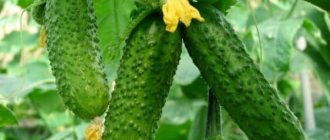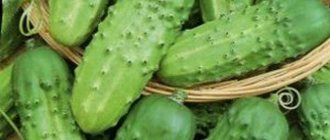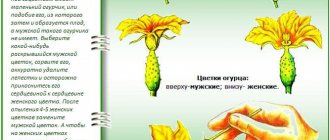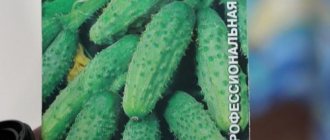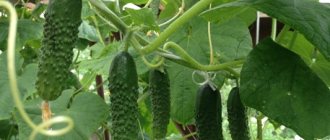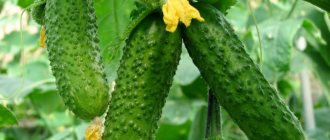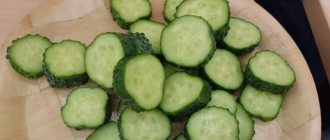Many breeding companies are entering the struggle to create improved varieties of cucumbers. The young company from Japan Kitano Seeds did not stand aside either. To the gardeners' attention, she presented a variety called KS 90 (probably the name came from the initial letters of the company). There is no information about the plant in the State Register of Breeding Achievements of the Russian Federation, but the developers indicate that the hybrid can be grown in open ground and in greenhouses. This means that it can be cultivated throughout Russia.
Cucumbers KS 90 f1: distinctive features
Cucumber KS 90 f1 is a hybrid variety characterized by early ripening: the first fruits ripen 35-39 days after the seedlings hatch. Cucumbers are famous for their high productivity and excellent taste characteristics: the fruits of the variety are crispy, juicy, with notes of sweetness and without bitterness.
Bushes KS 90 f1 belong to parthenocarpic varieties and are characterized by indeterminate growth. Like the Asker variety, the variety has developed lateral shoots with short internodes. Cucumbers are formed using the method of bunch tying, 5 greens in each knot:
- Cucumber varieties grow 9-11 cm long, and their shape resembles an elongated cylinder;
- The skin of the fruit KS 90 is dense, has a rich green color with white pubescence and large tubercles;
- The pulp of the hybrid culture does not have voids and is distinguished by its tenderness and crispy consistency.
Description
The plant is indeterminate, powerful, forms lateral shoots, which guarantees a large number of fruits. Internodes are short. Belongs to the vegetative-generative type. This means that the plant is actively developing and at the same time constantly forming ovaries. The leaves are large, heart-shaped, on long petioles, green in color. Venation is visible on the surface. The leaves, petioles and stem are slightly rough to the touch. From 3 to 5 greens are formed in the sinus. The root system is powerfully developed.
The fruits are small, gherkin-type, cylindrical, uniform, 8-12 cm long. The peel is coarsely tuberous, dark green in color. The spines are light and fall off easily when touched. The pulp is dense, crispy, juicy, without voids. Bitterness is genetically absent. The taste of cucumbers is excellent. The seed chamber is small. The seeds are soft.
Features of cultivation
Seeds of the variety from Japanese breeders are grown by seedlings and sowing methods. KC 90 f1 seedlings are planted in mid-April, and direct planting is carried out at the end of May. When sowing in the summer-autumn period, cucumber can be planted by seeding.
Preparing for landing
For sowing, choose fertile and non-acidic soils that differ in mineral composition. It is advisable to cultivate the KS 90 f1 variety in fed beds with a solution of manure, litter or compost.
In autumn, the soil is plowed to a depth of 20 cm. To prevent the soil from freezing over the winter, it can be covered with tops of some crop. Some vegetable growers prefer to plant mustard after harvesting, mow it after ripening and cover the prepared beds with tops. With the arrival of warm weather, the soil is cleared of tops and weeds, loosened to a depth of 6-7 cm and prepared for planting KS 90 seeds.
Growing seedlings
Before planting cucumber seeds, they must be hardened and germinated. The seed material KS 90 f1 is hardened using hot and cold water. Initially, the seeds are placed in hot water and kept there for 2-3 minutes, and then in cold water for the same period of time.
Sprout cucumber seeds in damp gauze. To do this, the seeds are wrapped in gauze and moistened. Then, the gauze is placed in a saucer and placed in a warm place, not forgetting to regularly moisten the seed material KS 90.
For seedlings, seedlings of the variety are planted in shallow peat vessels with a seed depth of 1.5-2 cm. It is recommended to plant 2 cucumber seeds in each hole to increase germination.
Planting seedlings
Seedlings of the cucumber variety are planted in a permanent place at the age of 35-40 days, when 4-6 leaves are formed on each bush, and the sprouts themselves reach 30 cm in height. Planting of KS 90 seedlings is carried out with a seedling depth of up to 7 cm. Each hole is sprinkled with soil to the bottom leaf and moistened with settled water. It is recommended to plant cucumbers according to a 50x60 cm pattern. After planting, the beds with cucumbers are wrapped with thick film.
Universal regulator KS 90-1 KS 92-1
The actual signal value is sent to the controller via a universal input. The second analog input can be used to measure, for example, heating current, as a setpoint input or as a position confirmation signal input for stepper motor controllers. An optional third input can be used as a universal input for a wide range of functions, e.g. temperature-dependent setpoint correction, differential control, etc. If necessary, different control levels can be protected from unauthorized access using a password or all levels can be completely locked.
- KS 90-1 has a frontal size of 48 x 96 mm - 1/8 DIN
- KS 92-1 has a frontal size of 96 x 96 mm - 1/4 DIN
- BluePort® interface and BlueControl® software
- Interface RS422 / RS485 Modbus RTU
- Maintenance interval and error list manager
- Two universal inputs
- Day & Night display with graphic and text display
- Two switchable parameter sets
- Pulse control of set value without fluctuation
- Stepper motor controller with feedback and DAC control
- Three-point regulator for cooling water, air and oil
- Simultaneous heating and cooling control
- Complies with DIN 3440, cUL approved
- High impedance mV input of O2 oxygen sensors
- Universal design - constant / switching mode
- Possibility of use with high-speed equipment
- Cycle time 100 ms
- Short control pulse – min. 20 ms
- 2 freely configurable analog outputs (output of actual parameter values)
- Specific measuring range with linearization depending on user specific conditions for all types of inputs
- Lockout with password and internal switches for process safety
- Wide temperature range up to 60 °C
- Correction of measured values by offset or two points
- Heating current monitoring and alarm output
- Emergency operation in case of sensor failure due to the use of an average setting value
- Logical connection of digital outputs, e.g. for issuing collective alarms
- A program controller option is available with 8 or 16 programs
- Built-in converter power supply
- Splash-proof front panel (protection rating IP 65)
- Default data set depending on user specific conditions
Typical applications: furnaces, burners and boilers, plastics processing, dryers, heat treatment, oil heat treatment plants, etc.
In addition to the supplied basic configuration of controllers, optionally (on request) it is possible to supply software controllers with the same name, but with a significantly expanded set of functions, in particular with 8 or 16 control programs available to the user.
Main features of the KS 90-1 Programmer:
- Total 8 or 16 programs (depending on order)
- 4 control lines
- 15 control segments per line
- Segment types: pulse (setpoint and time), pulse (setpoint and gradient), hold (time) segment, transition (with alarm suppression), end segment
- All segment types can be combined with a "wait" command at the end and an operator call
- Time unit is configurable in hours, minutes and seconds
- Max. segment duration: 9999 hours = 1 year 51 days
- Max. Duration of the program: 16 x 9999 hours = 18 years
- Gradient: 0.01 °C/h (/min) to 9999 °C/h (/min)
- The program name consists of 8 characters, set using the BlueControl software
- Frequency band adjustment: upper and lower bands are determined for each program separately
Specialized regulator KS 92-1 Carbon
designed for monitoring, measuring and PID regulation of carbon, oxygen, and dew point concentrations. The controller can control a stepper motor. The lambda probe produces an electrical signal (voltage), the magnitude of which depends on the ratio of the oxygen concentration in the oven and the oxygen concentration in the outside air. The KS 92-1 Carbon regulator converts the signal from the lambda probe, taking into account the measured oven temperature, into carbon concentration.
The lambda probe signal can be automatically checked periodically. When a critical signal value is reached, the regulator issues a notification, which may indicate the accumulation of soot and other contaminants on the surface of the probe. In this case, the KS 92-1 Carbon controller can control cyclic automatic rinsing and blowing of the probe.
The CO content can be determined using a gas analyzer, the analog signal from which is connected to the second input of the KS92-1 Carbon regulator. In this way, you can constantly adjust the calculated carbon concentration according to the firmware algorithm. Alternatively, carbon concentration can be specified as a parameter.
KS92-1 Carbon are used as standard for oxygen control with heated and unheated probes. Based on the probe voltage and temperature, the oxygen concentration is calculated, displayed and adjusted according to the Nernst equation. For heated probes, the temperature is set as a constant.
- Operating instructions (PDF 75 pages) in Russian are provided when ordering
- Technical data for the KS90-1 regulator (Russian)
Care
For successful cultivation and obtaining a large and tasty harvest, vegetable growers recommend adhering to certain rules of agricultural technology - following the advice on moistening, loosening and fertilizing the soil with KS 90 f1 cucumbers.
Hydration rules
It is necessary to water the beds with hybrid bushes every 2 days so that the cucumbers are juicy, crisp and not bitter. However, it is important to take into account that the soil is not too moist and does not dry out. Irrigation processes are carried out with warm water that has settled in the sun. It is recommended to water cucumbers under the root system so that water does not get on the foliage.
After every second watering, vegetable growers advise loosening the soil with KS 90 f1 cucumbers so that the seedlings receive the required amount of oxygen and moisture. Loosening is recommended to be done using a fork so as not to damage the root system of the variety.
Fertilizer application
Every 3 weeks it is recommended to feed the soil with mineral and organic components. It is advisable to fertilize beds with cucumbers in the evening at the root, trying not to get KS 90 on the foliage of the bushes.
Infections and pests
The hybrid variety KS 90 f1 is characterized by strong immunity to major diseases and pests. However, incorrect agricultural technology can lead to damage to the bushes of the variety with pathologies such as powdery mildew, wet rot and black flea infestation.
Powdery mildew
The most common infection is powdery mildew. Fungal spores enter the bushes of the KS 90 f1 variety through the air. As a result of the damage, the plants become covered with white mold, and the process of rotting of the fruits is also observed. At the initial stages of pathology, bushes can be treated with the following chemicals:
- "Raek";
- "Gamair";
- "Alirin";
- "Tiovit";
- "Bayleton";
- "Albite".
If the disease was not detected immediately, but after a while, the KS 90 plants are treated with whey, kefir or yogurt.
Wet rot
Infection with wet rot begins from the moment the seeds of KS 90 are planted. The pathology develops along with the plants and begins to appear at the moment the green varieties ripen. The main signs of infection are the formation of green spots on the tops of bushes, as well as the formation of necrosis. Darkening of the vessels of the stems is also observed, and the plant begins to die. The cucumbers themselves become covered with whitish mold and acquire a watery consistency.
It is recommended to treat bushes against infection with the following chemicals:
- "Home";
- "Rovral";
- "Bayleton."
Black flea beetle
The black flea beetle is a small pest that looks like parasites that regularly harm animals. The insect moves quite quickly, jumping from leaf to leaf KS 90. The pest is extremely dangerous for the bushes of the variety, since it is capable of destroying the crop in just a few days.
Signs of the appearance of a black flea beetle in the garden are the formation of holes on the foliage that resemble a sieve. In addition, the tops begin to dry out and wither.
It is recommended to treat the bushes of this variety against black flea beetles with the preparations “Aktara”, “Sherpa” and “Arrivo”. Some vegetable growers recommend spraying the bushes with a solution of garlic and tomato tops, as well as a mixture of chicken manure, steeped for 5 days.
About the features of agricultural technology
The following rules form the basis of the crop cultivation technique:
- cucumber shows better results when cultivated as seedlings;
- the optimal soil acidity indicator for a growing plant is 6;
- seedlings move to the beds at the age of 20 - 30 days, 2 sprouts per 1 m²;
- bushes are fixed on trellises;
- up to 7 leaves, the cucumber is completely blinded;
- the plant is formed into 1 stem.
Advice. To improve yield, fruits should be collected daily or every other day. The cucumber must be cut as close to the stem as possible, since new inflorescences form in place of the collected vegetables.
Sowing seeds for seedlings | Planting seedlings in a greenhouse/greenhouse | Planting OG seedlings | Stepsoning | Harvesting |
| May | When the seedlings are 20 – 30 days old | First week of June | Blinding up to 7 leaves | Since July |
| *dates are indicated for central Russia |
When to harvest?
Greens of the KS 90 f1 variety are collected as they ripen. It is important to ensure that the cucumbers have time to fully form and do not begin to outgrow. Untimely harvest of the variety leads to overgrowth of the cucumber and loss of the taste of the fruit.
It is advisable to store fruits of the KS 90 variety in cool rooms in small containers with holes. Vegetable growers use wooden boxes for storage that can allow oxygen to pass through to the greens.
Characteristics
- Early ripening variety. Fruiting occurs approximately a month after seedlings are planted;
- intended for spring-summer and summer-autumn rotation;
- the yield is excellent. The originators indicate unlimited yield. The peculiarity of our hero is that after harvesting the greens, the formation of the ovary occurs again, as at the very beginning of the growing season;
- the variety is parthenocarpic, which makes it possible to form a crop in closed ground without the help of pollinating insects;
- immunity, like all hybrids, is excellent. KS 90 is especially resistant to powdery mildew, which is the main enemy in greenhouses, and peronospora. Moderately resistant to cucumber mosaic virus;
- plasticity helps to withstand various stressful conditions, including frost on the soil;
- overgrown greens do not become barrel-shaped and keep their shape. You will also not find hooked cucumbers;
- tolerates transportation over long distances perfectly;
- shows excellent keeping quality. When properly stored, the fruits do not lose their presentation;
- The method of use is universal. Our hero is good in its natural form, suitable for canning and pickling.


